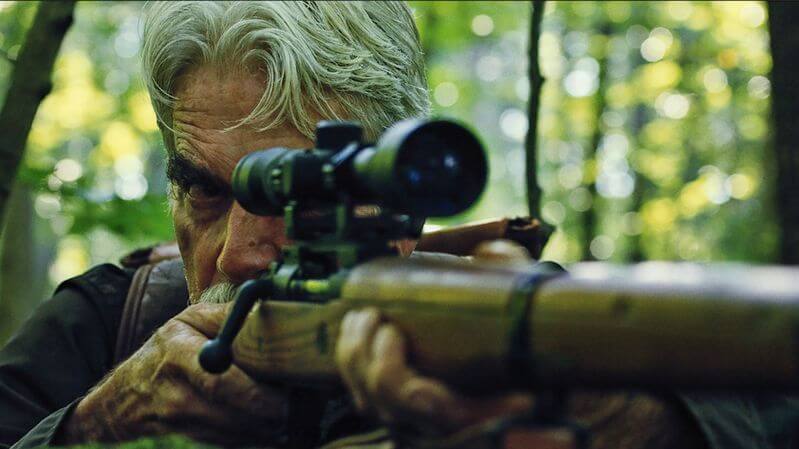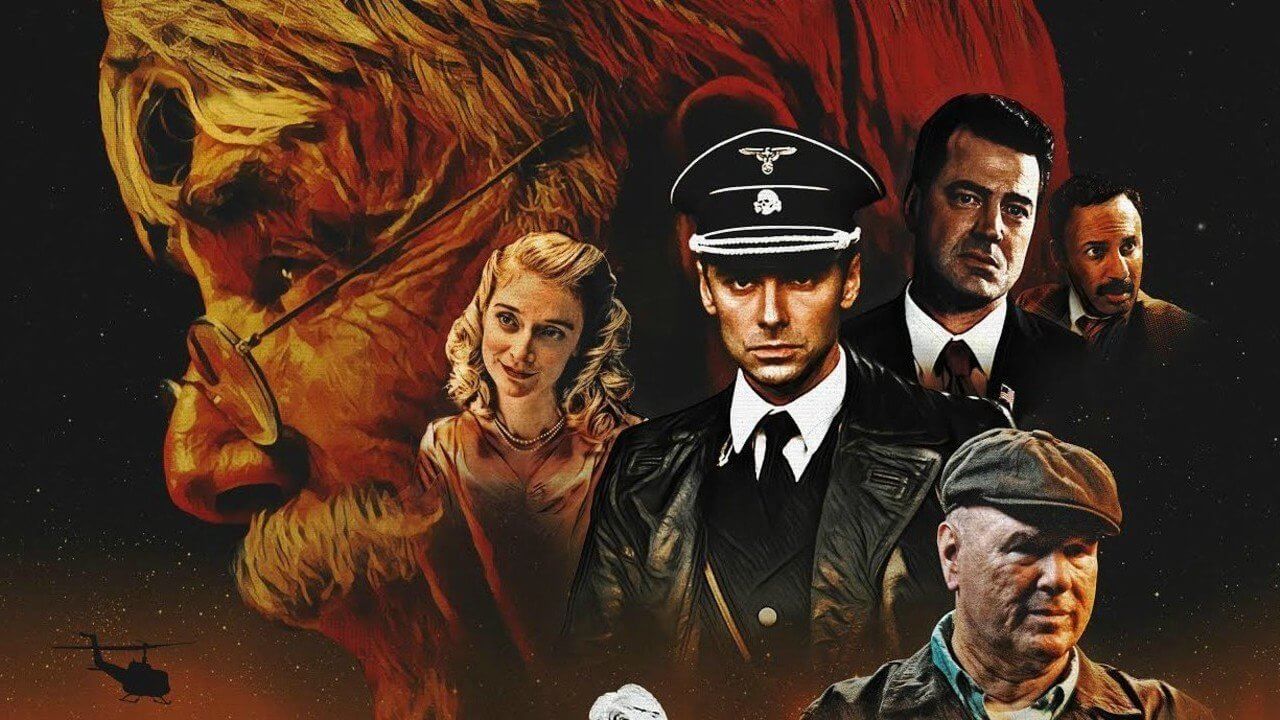Title: The Man Who Killed Hitler And Then The Bigfoot
Release Date: February 8th, 2019
Studio: Epic Pictures
Director: Robert D. Krykowski
Release Format: Limited Theatrical, VOD
This review will contain spoilers. I will be discussing some major themes and speculating on the nature of events that occur in the plot. This may affect your first viewing of the film. I highly recommend seeing this movie knowing as little as possible. Go ahead. I’ll be here when you get back.
At first glance, The Man Who Killed Hitler And Then The Bigfoot sounds like a campy romp in the vein of Snakes on a Plane. But as anyone who watched the trailer knows, this movie promised themes as deep and rich as Sam Elliott’s sultry bass.

Plot
The plot of The Man Who Killed Hitler And Then The Bigfoot occurs in two eras; World War II and present-day. In the movie, these two are interwoven through flashbacks. In the name of simplicity, I’ll run down the two parts separately in chronological order. In the second half of the review, I’ll circle back and discuss the way the movie presents its events and what that could mean.
The Man Who Killed Hitler And Then The Bigfoot focuses on Calvin Barr (younger version is played by Aiden Turner of The Hobbit with the present-day version played by Sam Elliott of Road House). Barr is a U.S. Secret Agent on a mission to cross behind enemy lines and assassinate Adolf Hitler. He meets with a band of vaguely eastern Europeans who provide him with his cover then gains access to Hitler. Using a makeshift gun, he shoots Hitler in the chest and then the head.
Before going to war, Barr courts Maxine (Caitlin Fitzgerald of Masters of Sex). He continually tries to propose to her before he leaves, but can never quite seem to get it right.
In the present day, Calvin Barr is alone except for his dog. After an evening drinking alone at a bar, he gets mugged by three men. One of them burns a picture of Maxine, which causes Barr to take out all three of them and destroy their gun. He is, after all, The Man Who Killed Hitler.

After the mugging, Barr throws out his medication. Shortly thereafter, he is approached by two government officials, one American (Ron Livingston of Office Space) and one Canadian (Rizwan Manji of The Dictator). They arrive unannounced at his home one night and tell him about a threat they would like him to eliminate. The Bigfoot is spreading some sort of super-plague through the Canadian wilderness and heading toward the American border.
Livingston’s father (forgive me for not using his character name, which is listed only as “Flag Pin”) had told him stories about a hero who killed Hitler. They believe Barr is the right man for this task as well. Barr kicks the two out of his house and the next day, he goes to consult with his brother, Ed (Larry Miller of Ten Things I Hate About You). There’s some soul searching, then Barr decides to take the mission.
Following a short “getting armed” montage, the movie cuts to Barr in the wilderness taking a shot at The Bigfoot. After winging the creature, Barr flees through the woods and falls and breaks his finger. He fixes himself, has a short conversation with Livingston, then tracks The Bigfoot to a cliffside where it lays seemingly dying. Rather than take another shot at it, Barr allows the creature to die peacefully.
Barr creates and lights a funeral pyre for The Bigfoot, which awakens when Barr lights the fire and flees. Barr chases it down and engages The Bigfoot in hand to hand combat. After a brutal fight, Barr triumphs and kills The Bigfoot, then seemingly lays down to die himself, alone in the wilderness.
There’s a funeral, Barr returns to go fishing with his brother and take in a school play.
Speculation
Let’s get this out of the way real quick: I do not believe the second half of the events of The Man Who Killed Hitler And Then The Bigfoot actually occur in reality. To me, this is a movie about a man dealing with guilt, regret, and loss in his twilight years.
Every line of dialogue in The Man Who Killed Hitler And Then The Bigfoot is dripping with meaning. One thing this movie does not do is deal in vagueness. If writer/director Robert D. Krykowski wants you to know something or make a connection, he puts it right on-screen. A lot of times this kind of hand-holding can be off-putting in a film, but somehow the tone and subject matter of The Man Who Killed Hitler And Then The Bigfoot make this work. I think it also has a lot to do with the Western movie earnestness of both the film and Elliott himself.
The clues are all there that this is a fantasy in Barr’s head. First off, the agents show up to recruit Elliott literally one scene after Barr tosses his medicine. As someone who takes a fair share of meds for everything from blood pressure to depression, I can tell you throwing those daily doses away would be more likely to send me into a downward spiral of angst and pain than turn me into a reluctant action hero.
The Man Who Killed Hitler And Then The Bigfoot also plays with time in an interesting way that suggests unreality. Barr’s swastika watch (the film’s one major conceit to its Inglorious Basterds-esque subject matter and tone) could not possibly be an effective chronograph. There are moments where it should clearly be night from the events of the film but the sun is out and vice-versa. And the jarring time jump from Barr standing outside a ring of fire to staring down a scope and shooting The Bigfoot. This all sets a tone of dreaminess and also speaks to the way that time can become jumbled for people in their later years.
The biggest hint (well… less “hint” and more “giant flashing billboard”) to Barr’s fantasy is the painting. Barr has a painting of a landscape with a river and a mountain hanging on his wall. This painting is the centerpiece of several shots in the film. Later, as Barr is tracking the Bigfoot, he is walking through a landscape that *is* the painting.
Barr feels powerless both about his inability to end World War II and his inability to have been with Maxine. He feels guilty about killing a defenseless man “even if he deserved it”. This Bigfoot fantasy is a way for him to cope, as killing The Bigfoot did, in fact, stem a tide of destruction in a way that killing Hitler could not.
I could frankly write another 10,000 words about the subtext and symbolism of The Man Who Killed Hitler And Then The Bigfoot, but for the sake of brevity, I’ll stop here.
Technical Feats
The Man Who Killed Hitler And Then The Bigfoot looks beautiful. This comes as no surprise as its visual effects crew includes giants like Douglas Trumbull (Blade Runner, Close Encounters of the Third Kind, 2001: A Space Odyssey) and Rocco Gioffre (Robocop, Watchmen). The shots are great and I loved the syphilitic Bigfoot design.
The performances by Sam Elliott and Aiden Turner are fantastic. I wish I could say the same about Caitlin Fitzgerald and Larry Miller, though they do light up the screen when they appear. Unfortunately, the movie doesn’t give them much to do. To be fair though, outside of Barr himself, this film doesn’t develop a lot of characters. This is very much a movie about one single character’s arc, and everyone else is there just to give him something to react to.
Verdict: The Man Who Killed Hitler And Then The Bigfoot is a movie everyone should watch but not everyone will like. Some people will find the dialogue and symbolism too hamfisted. Some will not understand why this story is being told. Some people will see this as just another in a long line of “old white man coping with his feelings through violence” movie. I think all of those would be valid critiques. But those of you who like this movie will REALLY like this movie. It’s the kind of film that works on both the level of pure awesome entertainment and can make you go back and think about it for weeks afterword.
[review]








